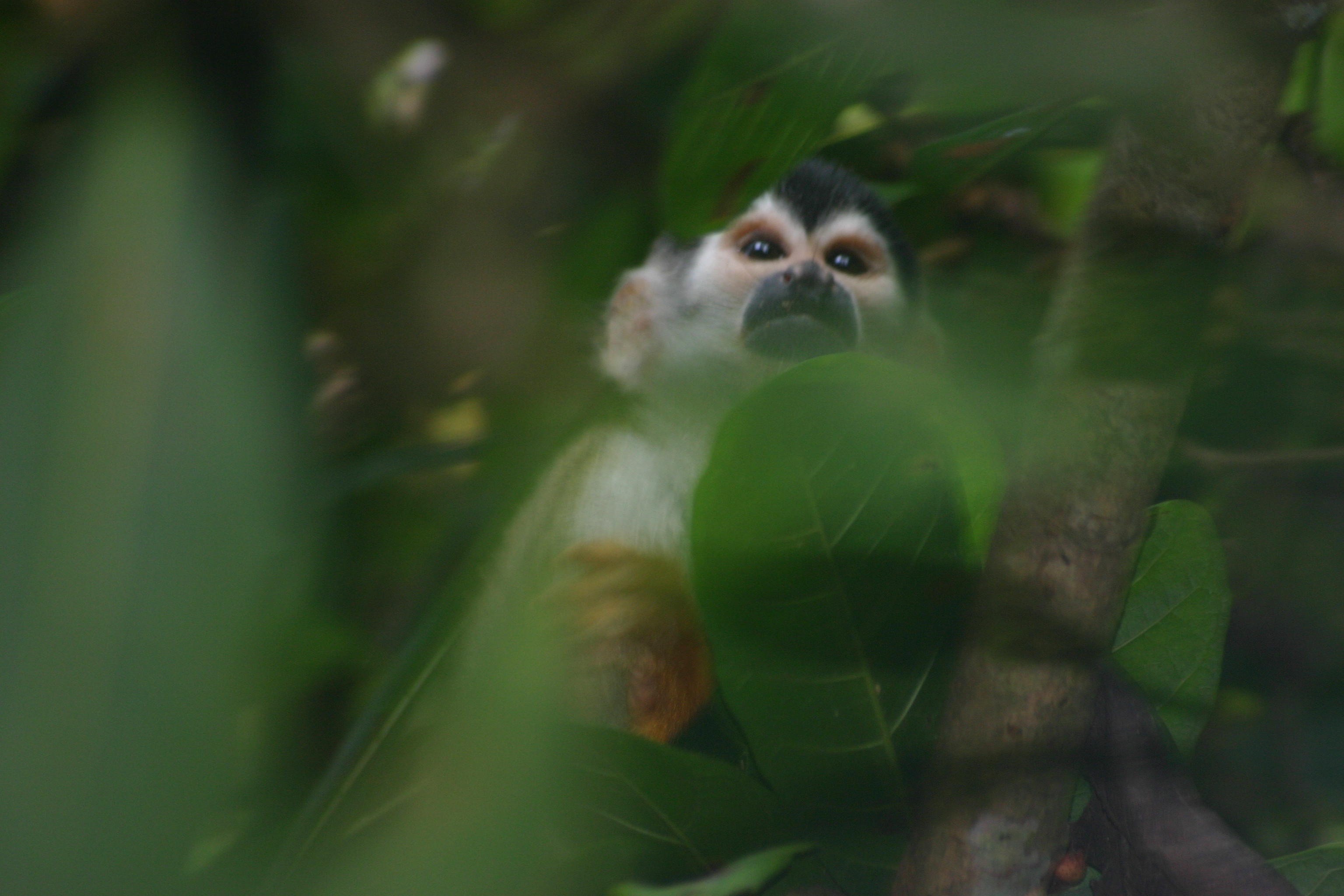- Central American Squirrel Monkey
Taxobox
name = Central American Squirrel MonkeyMSW3 Groves|pages=138-139|id=12100288]

image_width = 220px
status = VU
status_system = iucn3.1
status_ref = IUCN2008|assessors=Wong, G., Cuarón, A.D., Rodriguez-Luna, E. & de Grammont, P.C.|year=2008|id=19836|title=Saimiri oerstedii|downloaded=7 October 2008]
trend = down
regnum =Animalia
phylum =Chordata
classis =Mammalia
ordo =Primates
familia =Cebidae
genus = "Saimiri "
species = "S. oerstedii"
binomial = "Saimiri oerstedii"
binomial_authority = Reinhardt, 1872The Central American Squirrel Monkey ("Saimiri oerstedii") is a
squirrel monkey species fromCentral America . It is found inCosta Rica andPanama on thePacific coast. Even within Costa Rica and Panama the Central American Squirrel Monkey's range is highly restricted. Within Panama its range is limited to the Northern Pacific tip near the Costa Rica border, and within Costa Rica its range is limited to the Central and Southern Pacific coast, primarily in Maunuel Antonio and CorcovadoNational Parks .Description
The Central American Squirrel Monkey differs in coloration from squirrel monkeys from
South America . While South American squirrel monkeys tend to be primarily greenish in color, the Central American Squirrel Monkey has a reddish brown back with grey legs and white undersides. There is a black cap at the top of the head, and a black tip at the end of the tail. The face is white with black rims around the eyes and black around the nose and mouth.tatus
It was once believed that the Central American Squirrel Monkey was just a population of a South American species of squirrel monkey brought to Central America by humans. Evidence for this theory included the very small range of the Central American Squirrel Monkey and the large gap from the range of any other squirrel monkey species. However, a study of nuclear and
mitochondrial DNA demonstrated that the Central American Squirrel Monkey is indeed a separate species that apparently diverged from the South American species long ago - at least 260,000 years ago and possibly more than 4 million years ago.cite book | author = Rylands, A.; Groves, C.; Mittenmeier, R.; Cortes-Ortiz, L.; Hines, J.| editor = Estrada, A.; Garber, P.A.; Pavelka, M.S.M.; Luecke, L. | chapter = Taxonomy and Distributions of Mesoamerican Primates | title = New Perspectives in the Study of Mesoamerican Primates| pages = p. 38| id = ISBN 978-0-387-25854-6 | year = 2006]One popular theory is that squirrel monkeys did live in Columbia during the late
Miocene orPliocene and these squirrel monkeys migrated to Central America, becoming the ancestors of the current Central American species. According to this theory, theGuatemalan Black Howler migrated to Central America around the same time. However, passage through theisthmus ofPanama later closed due to rising oceans, and later opened up to another wave of migration about 2 million years ago. These later migrants, ancestors to modern populations ofWhite-headed Capuchin s,Mantled Howler s andGeoffroy's Spider Monkey s, outcompeted the earlier migrants, leading to the small range of the Central American Squirrel Monkey (as well as the Guatemalan Black Howler). [cite book | author = Ford, S.| editor = Estrada, A.; Garber, P.A.; Pavelka, M.S.M.; Luecke, L. | chapter = The Biographic History of Mesoamerican Primates | title = New Perspectives in the Study of Mesoamerican Primates| pages = pp. 100-107| id = ISBN 978-0-387-25854-6 | year = 2006]It has been estimated that the population of the Central American Squirrel Monkey has been reduced from about 200,000 in the 1970s to less than 5000.cite book|author = Hunter, L., Andrew, D.|title = "Watching Wildlife Central America"|year = 2002|pages = 148] This is believed to be largely due to
deforestation ,hunting , and capture for thepet trade. There are significant efforts within Costa Rica to try to preserve this monkey from extinction. [ [http://www.theboquetetimes.com/html/squirlmonkey.html Saving the Central American Squirrel Monkey ] ] [ [http://www.ascomoti.com/index.html Save the Mono Titi Manuel Antonio Costa Rica ] ] A reforestation project within Panama tries to preserve the vanishing population of the Chiriqui Province [ [http://www.saimiri.org/en -->] ] .ubspecies
Wikimedia Foundation. 2010.
